This two volume work on Positivity in Algebraic Geometry contains a contemporary account of a body of work in complex algebraic geometry loosely centered around the theme of positivity. Topics in Volume I include ample line bundles and linear series on a projective variety, the classical theorems of Lefschetz and Bertini and their modern outgrowths, vanishing theorems, and local positivity. Volume II begins with a survey of positivity for vector bundles, and moves on to a systematic development of the theory of multiplier ideals and their applications. A good deal of this material has not previously appeared in book form, and substantial parts are worked out here in detail for the first time. At least a third of the book is devoted to concrete examples, applications, and pointers to further developments.
Volume I is more elementary than Volume II, and, for the most part, it can be read without access to Volume II.
